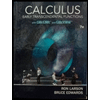
Concept explainers
To divide : using the long division
Answer to Problem 24RE
30x2−3x+85x−3=Quotient︷ (6x+3) +Remainder︷ 17 5x−3 ︸Divisor
Explanation of Solution
Given information : 30x2−3x+85x−3
Concept Involved:
- Set up the long division.The divisor goes on the outside of the box. The dividend goes on the inside of the box. When you write out the dividend, make sure that you insert 0's for any missing terms.
- Divide 1st term of dividend by first term of divisor to get first term of the quotient.The quotient is written above the division box.Make sure that you line up the first term of the quotient with the term of the dividend that has the same degree.
- Take the term found in step 2 and multiply it times the divisor.Make sure that you line up all terms of this step with the term of the dividend that has the same degree.
- Subtract this from the line above.Make sure that you subtract EVERY term found in step 3, not just the first one.
- Repeat until done.You keep going until the degree of the "new" dividend is less than the degree of the divisor.Use the long division to find the other factor of the function
- Write out the answer. Your answer is the quotient that you ended up with on the top of the division box. If you have a remainder, write it over the divisor in your final answer.
The Division Algorithm : If f(x) and d(x) are polynomials such that d(x)≠0 , and the degree of d(x) isless than or equal to the degree of f(x) , then there exist unique polynomials q(x) and r(x) such that f (x)↑Dividend = d(x)↑Divisor⋅q(x)↑Quotient + r (x)↑Remainder where r(x)=0 or the degree of r(x) is less than the degree of d(x) . If theremainder r(x) is zero, then d(x) divides evenly into f(x) and k can be called as zero of the polynomial.
Calculation:
Step 1: Set up the long division. The divisor goes on the outside of the box. The dividend goes on the inside of the box. When you write out the dividend, make sure that you insert 0's for any missing terms.
5x−3)¯30x2−3x+8
Step 2: Divide 1st term of dividend by first term of divisor to get first term of the quotient. The quotient is written above the division box. Make sure that you line up the first term of the quotient with the term of the dividend that has the same degree.
| 6x5x−3)¯30x2−3x+8 | 30x25x=6x |
Step 3: Take the term found in previous and multiply it times the divisor. Make sure that you line up all terms of this step with the term of the dividend that has the same degree.
| 6x5x−3)¯30x2−3x+8 30x2−18x | 6x(5x−3)=30x2−18x |
Step 4: Subtract this from the line above.Make sure that you subtract EVERY term found in step 3, not just the first one.
| 6x5x−3)¯ 30x2 − 3x+8 +(−) 30x2 −(+)18x _ 15x+8 |
Step 5: Repeat until done. You keep going until the degree of the "new" dividend is less than the degree of the divisor. Use the long division to find the other factor of the function
| 6x+35x−3)¯ 30x2 − 3x+8 +(−) 30x2 −(+)18x _ 15x+8 | 15x5x=3 |
Step 6: Take the term found in previous and multiply it times the divisor. Make sure that you line up all terms of this step with the term of the dividend that has the same degree.
| 6x+35x−3)¯ 30x2 − 3x+8 +(−) 30x2 −(+)18x _ 15x+8 15x−9 | 3(5x−3)=15x−9 |
Step 7: Subtract this from the line above.Make sure that you subtract EVERY term found in step 3, not just the first one.
| 6x+35x−3)¯ 30x2 − 3x+8 +(−) 30x2 −(+)18x _ 15x+8 +(−) 15x−(+)9 _ 17←Remainder |
Conclusion:
By dividing the given polynomial 30x2−3x+8 by 5x−3 using the long division we get the quotient as 6x+3 and the remainder as 17 .
30x2−3x+85x−3=Quotient︷ (6x+3) +Remainder︷ 17 5x−3 ︸Divisor
Chapter 2 Solutions
Precalculus with Limits
- quick solve thisarrow_forwardquick solve thisarrow_forwardThis table displays the current in equal intervals. Time t/ms 05 10 15 20 25 30 Current i/A 0 4.8 9.1 12.7 8.8 3.5 0 The formula for the charge as follows: 30x10-3 q 0 i dt Use formula to solve the current at 30ms using both the trapezoidal rule and Simpson's rule showing all steps and workingarrow_forward
 Calculus: Early TranscendentalsCalculusISBN:9781285741550Author:James StewartPublisher:Cengage Learning
Calculus: Early TranscendentalsCalculusISBN:9781285741550Author:James StewartPublisher:Cengage Learning Thomas' Calculus (14th Edition)CalculusISBN:9780134438986Author:Joel R. Hass, Christopher E. Heil, Maurice D. WeirPublisher:PEARSON
Thomas' Calculus (14th Edition)CalculusISBN:9780134438986Author:Joel R. Hass, Christopher E. Heil, Maurice D. WeirPublisher:PEARSON Calculus: Early Transcendentals (3rd Edition)CalculusISBN:9780134763644Author:William L. Briggs, Lyle Cochran, Bernard Gillett, Eric SchulzPublisher:PEARSON
Calculus: Early Transcendentals (3rd Edition)CalculusISBN:9780134763644Author:William L. Briggs, Lyle Cochran, Bernard Gillett, Eric SchulzPublisher:PEARSON Calculus: Early TranscendentalsCalculusISBN:9781319050740Author:Jon Rogawski, Colin Adams, Robert FranzosaPublisher:W. H. Freeman
Calculus: Early TranscendentalsCalculusISBN:9781319050740Author:Jon Rogawski, Colin Adams, Robert FranzosaPublisher:W. H. Freeman
 Calculus: Early Transcendental FunctionsCalculusISBN:9781337552516Author:Ron Larson, Bruce H. EdwardsPublisher:Cengage Learning
Calculus: Early Transcendental FunctionsCalculusISBN:9781337552516Author:Ron Larson, Bruce H. EdwardsPublisher:Cengage Learning





